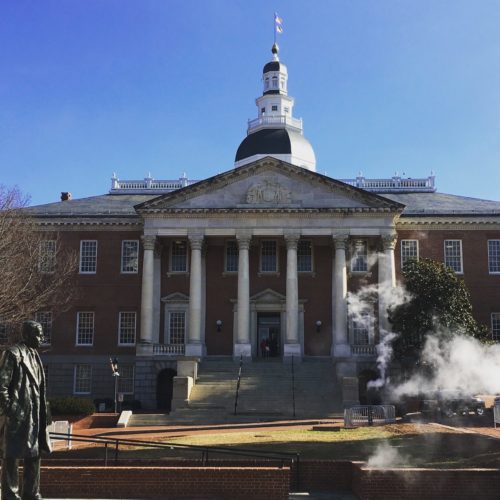Pursuing regional approaches on the road to a low-carbon economy
This article appears in the 2019-2020 edition of CSG East’s Perspectives Magazine.

Credit: LanaElcova/Shutterstock.com
When Connecticut State Senator Gary Winfield considers how a new multistate effort to reduce vehicle emissions could truly benefit his community, his advice is to start by improving public transportation.
Winfield represents New Haven and West Haven, and many of his constituents cannot afford a car. When they travel, they depend on buses that are often slow and unreliable. It can take an hour and a half to get to a job at the nearby mall, compared with less than a half hour by car, he said.
“That means there’s something wrong with that transportation system,” said Winfield during a panel discussion organized by CSG/ERC’s Energy and Environment Committee at Yale University last October.

Connecticut State Senator Gary Winfield
Credit: Connecticut Senate Democrats
Connecticut is among 12 northeastern states participating in the Transportation and Climate Initiative (TCI), whose state agencies, together with officials from the District of Columbia, are working to devise a cap-and-invest program for tailpipe emissions. The intent is to transition the region’s transportation system toward electrification and dramatically lower climate-warming pollution from the transportation sector, the largest source of greenhouse gas emissions nationwide. The program is also expected to enhance public health and lead to new jobs in the clean-energy economy.
The panel discussion was held in conjunction with CSG/ERC’s Northeast Climate and Energy Summit, which was hosted by the Yale University School of Management and the School of Forestry and Environmental Studies. The dialogue provided Winfield and other legislators the opportunity to speak directly with state agency officials who are leading the TCI effort and offer suggestions for ways the program could be designed to provide tangible quality-of-life improvements for their constituents.
An Emphasis on Flexibility
TCI would limit emissions from the transportation sector and lower that limit, or cap, over time. Bulk fuel suppliers would hold an “allowance” for each ton of pollution they were responsible for. The allowances would be auctioned, and states would have the flexibility to invest the proceeds as they wished. The approach is modeled after the nine-state Regional Greenhouse Gas Initiative (RGGI), which has implemented a market-based system to reduce emissions from the electricity sector since 2009.
Since it took effect a decade ago, RGGI has reduced carbon emissions from the electricity sector by more than 50 percent in participating states, generated more than $4 billion in net economic value through 2017, and led to the creation of 40,000 new jobs, according to research from the Analysis Group, a consulting firm. The proceeds have been invested in energy efficiency, renewable energy, direct bill assistance, and greenhouse gas abatement projects.
“Part of the reason why RGGI has persevered is that it leaves flexibility to the states wherever it can. It’s a powerful track record of success from RGGI that we are now looking to implement in the transportation sector,” said Katie Dykes, commissioner of the Connecticut Department of Energy and Environmental Protection, during the conference.
Winfield said he hopes TCI’s final proposal will include realistic transportation options that will help communities like his. Many of his constituents would benefit from more reliable, cleaner public transportation services that improve air quality and cut down on commuting times, he said, and buying an electric vehicle is typically not an option.
“Even if we are giving them cash back for [the purchase of an electric] vehicle, they are not going to be able to get that vehicle we want them to get,” he said.
In a draft proposal released last October, participating states said TCI would prioritize issues around equity. Specifically, the program seeks to expand low-carbon and clean-mobility options in historically underserved communities or those heavily affected by transportation pollution.
TCI was soliciting feedback ahead of the release of a draft memorandum of understanding (MOU) at the end of 2019. After considering further public input, TCI expects to release a final MOU in the spring of 2020. Each jurisdiction will then decide whether to sign and participate in the program.
The Importance of Collaboration
The conference at Yale was among a series of climate and energy summits organized by the CSG/ERC Energy and Environment Committee in recent years to help states explore ways to collectively benefit from the transition to a low-carbon economy. The event brought together more than 100 state officials and staff from northeastern states and eastern Canadian provinces, who also explored innovative solutions for reducing emissions in the electricity system, agriculture, buildings, and the waste management sector.
In a brief address during the conference, Connecticut Governor Ned Lamont emphasized the need for a state like Connecticut, which is heavily reliant on natural gas imports from outside the region, to collaborate with its neighbors as it seeks to reduce harmful transportation pollution along the Interstate 95 corridor and promote an offshore wind sector. “All of our issues don’t stop at the border,” said Lamont.

Connecticut Governor Ned Lamont, speaking during CSG East’s 2019 Northeast Climate and Energy Summit at Yale University.
Earlier in the year, Lamont signed a bill calling for Connecticut to have a carbon-free electric grid by 2040. That came on the heels of historic state legislation in New York setting the same 2040 target for zero-carbon grid power and a goal of reaching carbon neutrality from all sectors of the economy by 2050. A number of other states, including Maine, are aiming to get all of their power from zero-carbon sources by midcentury and to accelerate their carbon reduction goals.
Offshore wind figures prominently in policymakers’ plans to reduce the region’s reliance on fossil fuels. Northeastern states have collectively pledged to develop more than 17,000 megawatts of ocean-based wind energy within the next 15 years, and some 25,000 megawatts are already in various stages of development off the East Coast.
Developing abundant sources of zero-emission power will be critical to reducing pollution from transportation through TCI, as drivers increasingly opt for vehicles powered by electricity instead of petroleum.
During the conference, members suggested other areas that would benefit from close collaboration among states, including efforts to sequester carbon through agricultural and forestry practices.
“It was one of the most productive conferences I’ve attended,” said Vermont State Representative Mike Mrowicki. “Within the time we shared, each part was informative, accessible, timely, and will help me do the work I was elected to do in the arena of climate issues.”
The Energy and Environment Committee plans to host meetings and workshops during the course of 2020 to help officials accelerate the development of transformative policies.
“We are on the cusp of a sustainability revolution that will create hundreds of thousands of good-paying jobs in the region and in the nation — as long as we stick together and do what needs to be done,” said Massachusetts State Senator Marc Pacheco, who is co-chair of the CSG/ERC Energy and Environment Committee. “This is one of those rare opportunities where what we do today will truly have an impact on generations to come.”





